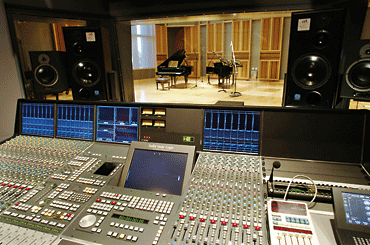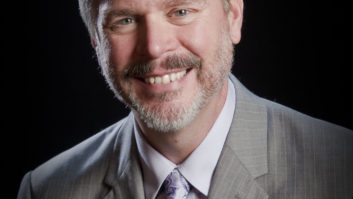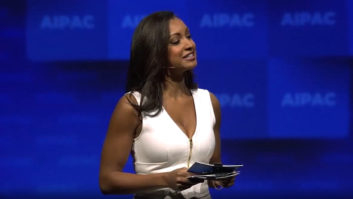
Radio control room A at WGBH Boston has an SSL C200 console.
Photo: Andy Washnik
It’s a safe bet that every broadcaster, network and facility manager across America has February 17 circled in red on their 2009 calendars. And as that D-Day approaches for the mandated analog-to-digital television transition, there’s a lot of retrofitting, rebuilding and renovation going on. That part is hardly news to folks in the industry — the confusion that kicks in that day among average Joe/Jill consumers will be the real scary part, but that’s another story.
In addition to offering the improved resolution, channel selection and full-on surround capabilities that DTV provides to end-users, the upcoming changeover gives broadcasters and content producers a good excuse to upgrade their facilities. The key here is not simply a transmitter revamp, but examining every aspect of the production/transmission chain. And this extends not only to cameras, monitors, switchers and mixers, but also to the system’s entire backbone — routers, servers, storage, archives, hubs, communications, acoustics, lighting, floor plans, etc.
We spoke to integrators from three facilities in the process of their HD/DTV upgrade. All embrace the bump to higher-resolution HD programming, but they also see this as a chance to provide more ergonomic workflows with the added benefit of greater reliability and faster production. These facilities — the Trinity Broadcast Network, World Wrestling Entertainment and WGBH Boston — serve highly divergent audiences, but all share a common zeal for production excellence. Analog or digital, some things never change.
TRINITY BROADCASTING NETWORK
Based in Southern California, TV Magic is a broadcast and A/V systems integrator and engineering company founded nearly two decades ago. TV Magic has completed some 200 projects during that time, ranging from the CBS Studio Center production truck to a full HD production infrastructure for the Crystal Cathedral Ministries’ Hour of Power program.
Featured on more than 5,000 television stations, 33 satellites, the Internet and thousands of cable systems, the Trinity Broadcasting Network (TBN) is the world’s largest Christian TV network. Two years ago, TBN asked TV Magic to design a flexible, automated master control system supporting five DTV channels, and install that system across 32 of the network’s affiliate stations throughout the United States. Having completed that, TV Magic is now implementing a full redesign of TBN’s facility operations center in Tustin, Calif. That complex has five studios and does audio sweetening and post-production, but “the audio control is about 20 years old — all analog — and limited as to what it can do,” says TV Magic design engineer Craig Claytor.
“We designed a new state-of-the-art facility for TBN in Costa Mesa [near Tustin] that’s all HD,” he continues. “It also has a huge live audience facility that’s also all-HD, with an SSL C200 in it. They’ve pretty much standardized on that mixer and put them into their facilities in New York and Dallas. So essentially we’re doing the same thing in Tustin, bringing that facility up to date.”
Still under construction, the Tustin facility is slated to be completed in early summer 2008 and is expected to mirror many of the approaches that were successful in other TBN installs. The acoustician is Carl Yanchar (who also did the Costa Mesa facility), and surround monitoring is via Klein & Hummel.
With a variety of programming and project needs, one of TBN’s considerations was versatility. “We’re using the SSL’s Stage Boxes in the studios as a fiber interface into the mainframe so they can put two Stage Boxes into each of the studios, with 48 mics from each — up to 96 mic feeds total, plus about 40 returns and GPI for control,” Claytor explains. “They’re mounted in roll-around cases so they can easily be moved from studio to studio. For redundancy, there’s copper wiring as a backup, as well as a smaller Yamaha DM2000 mixer, in a second control room, which is used for simultaneous shows in two different studios or to serve as a backup.”
Both rooms are fed from a router. “We use a lot of MADI interfacing to feed the AES/EBU back and forth within the facility. MADI is nice, handling 64 channels on a single cable. In a large, stretched-out facility where the cable conduits are already mostly full, MADI allows us to do things we couldn’t do otherwise,” says Claytor. In terms of longer-distance file exchanges, “We also have a DigiDelivery system for moving Pro Tools files from facility to facility. With studios in New York, Atlanta, Nashville, Dallas, Costa Mesa and Tustin, there will be a lot of file transfers.”
With TV Magic’s proven track record, there are always nuances and lessons to be learned. “One thing that’s been an issue in all facilities is maintaining lip-sync with the video,” Claytor continues. “Whenever you process the video or route it to a different machine, you stand a chance of losing sync. Multiple delays often occur in video equipment, so it’s absolutely necessary to have an audio delay line with each piece of video gear, every time we up- or down-convert. It’s less of a problem with embedded audio, especially when the metadata is there, as well.”
There are other less-obvious, but still important aspects to maintaining A/V synchronization. “All the video monitors in the audio studios have to be HD-capable,” Claytor warns. “When viewing an analog monitor that’s been down-converted, you could be seeing a lip-sync issue that’s not really there, with two or three frames of delay. A lot of thought needs to be put into that process.”
WORLD WRESTLING ENTERTAINMENT
For nearly a quarter-century, World Wrestling Entertainment (WWE) has attracted a tremendous, global audience. WWE’s flagship television programs include Monday Night RAW on the USA Network and SmackDown on UPN — both top-rated shows.
The company recently began a $20-million transition to HD, including two new state-of-the-art production trucks and HD file-based workflow and systems upgrades to its WWE TV Production facilities at its headquarters in Stamford, Conn. As part of the transition, WWE signed a $12-million deal for a Thomson server-based HD production and distribution workflow that includes services from Thomson, along with a Nesbit Systems media asset-management (MAM) system.
“It’s been a huge upgrade over the past year,” says director of audio post-production Chris Argento, a 13-year veteran at WWE. “We’ve secured a Grass Valley K2 server, and our NLE (non-linear editing) has gone to the Grass Valley Aurora systems. These are complemented by Final Cut Pro. When we moved to HD, we put in the K2 server, which I believe is one of the largest in the world.”
WWE’s HD digital production system will have 16 HD ingest channels and a minimum capacity of 2,000 usable hours of HD with 15,000 hours of online disk base proxy storage. The system is designed to support 200 named users and 50 simultaneous users, 20 full-resolution viewing seats and 36 full-featured multistream NLEs.
Unfortunately, with a constantly busy schedule, there simply isn’t time to shut down during renovations — certainly a problem shared by other facilities. “The HD video has been an enormous upgrade, especially considering the throughput we’re keeping up with every week from our two new trucks in the field,” Argento adds.
But with all the attention to HD picture, the audio side hasn’t been ignored. “In terms of audio, we’re moving OMF files from the Auroras and the Final Cut Pros. Right now, we’re working with proxy video in SD, but we’ll be moving to HD once we upgrade our Fairlight systems to the Crystal Core technology. Currently, we’re working on the QDC machines, which have been rock-solid for years, but Fairlight’s Crystal Core has embedded Picture Track, with full HD video right on the audio timeline.”
Most of the audio flow at the WWE TV Production complex involves audio post-sweetening and sound editing for shows, and sound design for what seems to be an unending string of promos and spot campaigns. “We’re working on Fairlights and mixing on Euphonix System 5s — in fact, our third System 5 comes online in a couple weeks. They’re great desks — the speed factor is awesome and the automation is phenomenal. It’s not a desktop, mixing-in-the-box setup, but it’s worked out pretty well,” says Argento. “In terms of archiving effects, with Fairlight’s AudioBase it’s been incredibly easy to keep track of everything. We also have an mSoft server, which keeps all our generic effects libraries — Sound Ideas, DigiFx and such. We do a lot of last-minute promos right before airing, and it’s easy to find what we need in a hurry.”
In terms of the transition to surround sound, Argento is more concerned about making it happen correctly rather than quickly. “We’re delivering in stereo now, but we’ve been building up our crowd libraries in 5.1, from hanging surround mics in the arenas. No crowd sounds quite like a wrestling crowd!
“In the next six to eight months,” he adds, “I’m looking to take the program to full 5.1, but now we’re still doing stereo. We don’t have a set timetable or schedule for moving to full 5.1 production. Digital TV does not require 5.1, although it enables you to do that. We want to make sure that when we go to 5.1, it’s good and isn’t just gratuitous so we can say we have six channels. And we’re going to be less static than most other people have done. We’re not simply going to throw ambience into the rear channels; ours will be dynamic. When we do things here, we really do it. We like to do things big.”
WGBH BOSTON
Having offered systems integration, design and consultancy services to top-drawer clients such as Viacom, Saturday Night Live, CNBC, CNN and Fox News over the past two decades, New Jersey-based The Systems Group was an excellent choice to handle design of the all-new WGBH Foundation production and post operations.
Completed this past October, the WGBH project included at least six rooms equipped for HD surround mixing and sound for HD picture. With two audio control rooms in the radio area and two audio post rooms, two audio production control rooms for TV and 30 to 40 Avid systems, it’s hardly your typical public broadcasting facility, according to TSG’s VP of engineering and technology, Scott Griffin, who leads TSG’s engineering and consulting team.
“What they call ‘FM One’ is a full-scale, large recording studio,” notes Griffin. “It’s based on an SSL C200 digital console. The rooms are all acoustically designed by Janson Design Group and the surround audio throughout the plant is all Dolby-E-encoded. Uncompressed audio between Avid-and-Avid and Avid-to-Pro Tools is handled as OMF files. In the radio environment, files are sent to Broadcast Electronics’ AudioVAULT, with trading of WAV and BWF files between the two sides of the building, as well.”
As in any large facility, efficient file exchange is critical. “We migrated them to a large Grass Valley K2 play-to-air server and they have some legacy Grass Valley units used for play-to-production,” Griffin says. “Using universal interface modules, they are actually moving video files from the individual Avid suites into the recording/production server. There are also a number of Avid Unity servers that different workgroups use, and several stand-alone systems, where files are simply sneaker-netted. We made sure that every Avid workstation had a network connection to a SAN or to the production servers for FTP’ing files from the north post-production building across fiber connections to the south production building, which has the TV Air and Radio Air rooms.”
Yet even with major upgrades, there are still small snags that can crop up and wreak havoc with the audio. “Even in some of the newer DTV stations, the surround environment in master control is iffy. Time and time again, my guys are amazed that master switcher manufacturers aren’t putting more control options into their monitoring sections, so you could actually hear what’s coming out and what’s coming off-air,” Griffin warns.
“I want to see what it sounds like in surround or in stereo, or how it sounds in mono,” he continues. “All public broadcasters have a wealth of surround and HD programming, and there are many master control rooms that aren’t equipped to monitor problems like phase cancellation or indicate when channels aren’t where they’re supposed to be. Even if there’s something as simple as a phase flop, there’s no way to tell.”
Another issue that needs more attention is “the interface between the automation systems and the traffic systems, and how things are handled in the surround environment,” Griffin adds. “This includes the whole interplay of the BXF standard and how it would handle switching between a 2.0 source on one program segment and a surround source on the next. Right now, we’re a year away from everybody having DTV; will that set-top box be switching correctly to match the format of the program coming in? The BXF standard is in development right now, and a lot of the automation and traffic vendors are developing on it, but the fruits of those labors are yet to be fully realized.”
George Petersen is Mix‘s executive editor.




